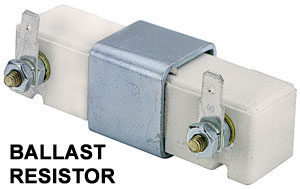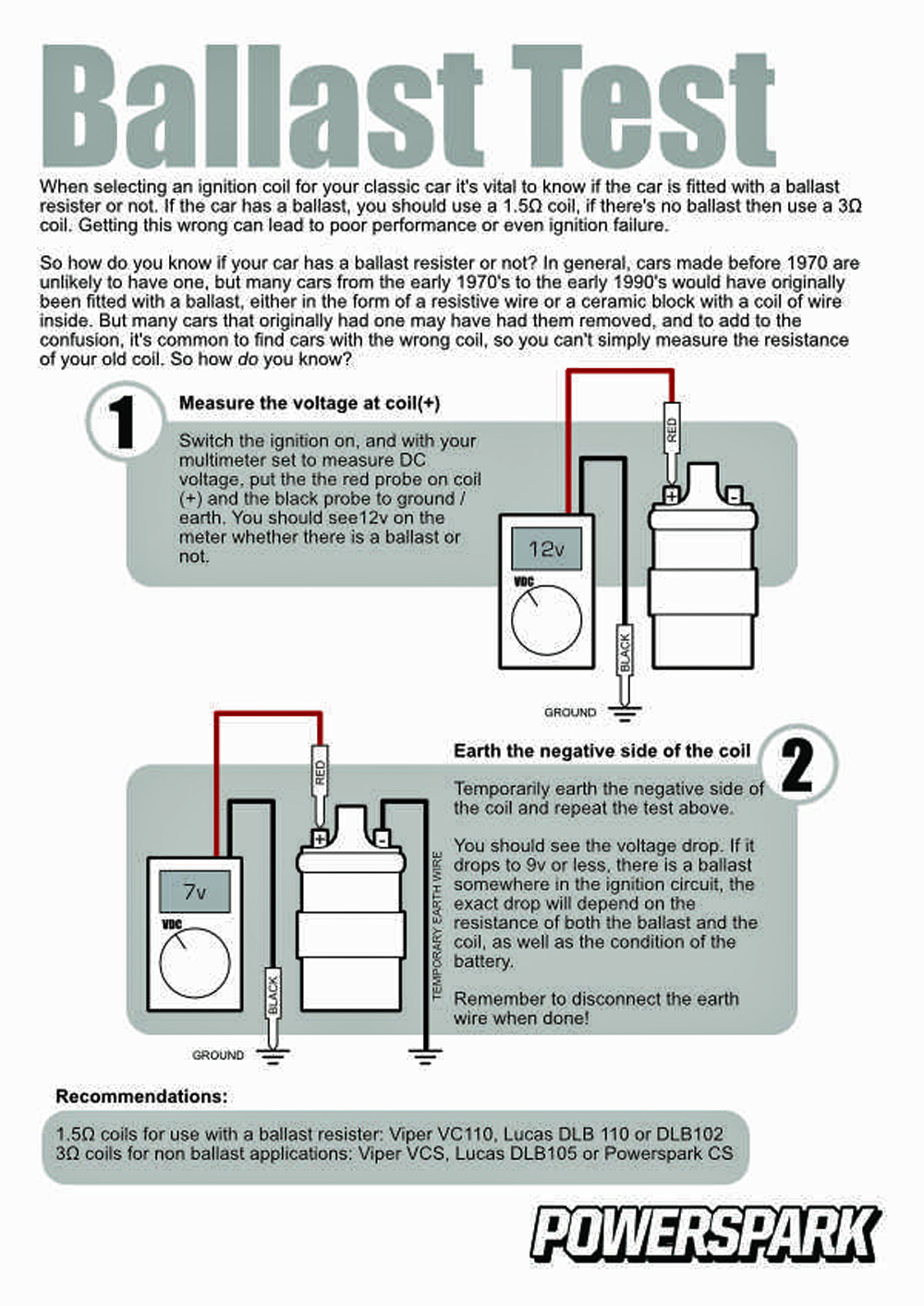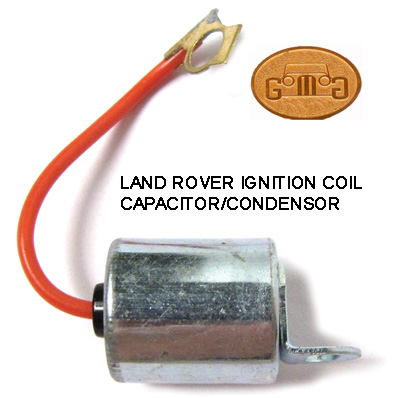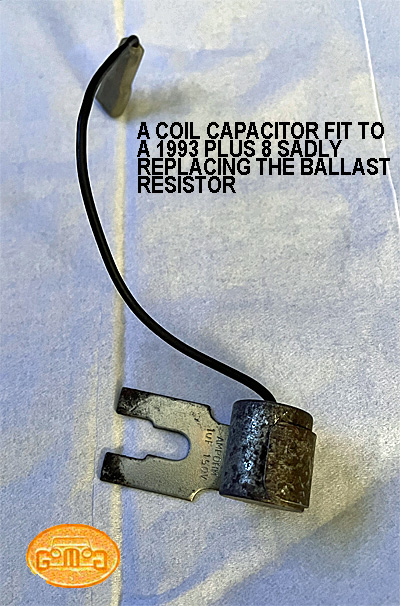IGNITION BALLAST RESISTOR AND/OR CONSENSOR/CAPACITOR
by Lorne Goldman & Ted Bridge
This can be a very frustrating issue for British cars fit with an ignition coil and distributor. Most Morgan Plus 8s (overseas excepted) were fit with distributors until 2000.
|
A. Foreword
B. Understanding a Ballast Resistor
C. Testing a Ballast Resistor
D. Advantages and Disadvantages of a Ballast Resistor Over a Capacitor/Condensor
E. Condensor Capacitors
FOREWORD
I have now run across three instances of a bad condenser or ballast resistor in Morgans up to the point their ignitition systems began to use coil packs (circa 1996-2002 from a faulty memory). If I am noticing that fault cropping up..it is the time for an article. It is very difficult to diagnose. The symtoms are varied:
1. The car can run for 20 minutes or so, but then stalls, Only
restarting after a rest. if you are lucky This is because the coil is
overheated and its internal oil is boiling.
2. The car will run unsteadily. This is because;
a: The lack of one (ballast resistor or condensor/capacitor
causes a too high voltage to run through the coil and the distributor,
damaging the coil (which will become EXTREMELY HOT) and the distributor
cap
3. The car will overheat, yes the coil becomes so hot that it heats the engine!!!.
Understanding a Ballast Resistor
A Ballast Resistor is an electrical device that reduces voltage to
the coil so that more energy is available for the spark plugs during
starting. Its resistance increases as current flows
through it is increased and its resistance reduces as current flows
through it drops. As a result, a device that helps to preserve voltage
stability. This added stability increases ignition and running stability. Additionally, their
usage reduces
the chances of coil failure by reducing coil voltage and
current, ensuring that the coil does not overheat as a result of the
addition. An overheated coil quite often causes damage to distributor
and its amplifier. The high heat of a over-heated coil also increases
engine bay temperatures to sad effect.
Traditionally, ignition systems didn’t use a ballast, meaning that
the ignition system used a 12v coil with a 12v feed from the battery via
the  ignition switch. This system is fine when the engine is running. However, it can be
problematic when starting because the starter motor draws a huge amount
of current from the battery, leaving the ignition system and the spark plugs with less energy
to create sparks. This is mad worse during colder starting temperatures or
when the starter motor is worn, requiring even more energy for the
starter motor and leaving less available for the spark plugs.
ignition switch. This system is fine when the engine is running. However, it can be
problematic when starting because the starter motor draws a huge amount
of current from the battery, leaving the ignition system and the spark plugs with less energy
to create sparks. This is mad worse during colder starting temperatures or
when the starter motor is worn, requiring even more energy for the
starter motor and leaving less available for the spark plugs.
To
counteract this distribution of energy, ignition systems were changed
to use a 9v coil instead of a 12v coil. A 9v coil gives the same output
as a 12v coil when provided with a 12v feed, resulting in a better
spark for starting with less energy draw on the starter motor. Once the
engine is running, the 12v feed is cut and the coil continues to run on
the 9v feed.
Which coil should I use if my car has a ballast resistor?
MAJOR WATCHPOINT: Never try to run a ballast resistor or condensor system
when a ballast resistor is not present in the ignition system unless
you have changed the entire system! Damage to all components downstream
of where these deviceswere placed which is before the coil, BEGINS IMMEDIATELY. In minutes, you have damaged anything there or newly put in. Coil, points, cap, electronics....
N.B. There ARE
internally ballast resisted coils. Mallory coils with red tops are one
such coil. However, I do not recommend them. Ballast resistors are
inexpensive and reliable. There are made of cermamic to absorb heat.
Ballast resisted coils give OFF heat.
|
Testing a Ballast Resistor
To test the ballast resistor in automotive applications an ohmmeter or a multimeter is needed.
If the ignition
coil is not linked to the ballast resistor, the ignition coil receives
the entire supply voltage. The battery is usually utilized to power  the
ignition system. The battery voltage will most likely be 12V in most
circumstances. If the voltage level decreased to 7-8V after connecting
the ballast resistor, then the ballast resistor will be in good
condition. However, if the voltage level of the ignition coil will be
high it means the ballast is damaged. So, to extend the life of the
ignition coil we need to lower the voltage and for this purpose we
connect a ballast resistor to the ignition coil to decrease the
voltage. Test for voltage at the power entry side..should be 12+Volts.
Now test for voltage at the end wired directly to the positve side of
the coil. It should be lower.
the
ignition system. The battery voltage will most likely be 12V in most
circumstances. If the voltage level decreased to 7-8V after connecting
the ballast resistor, then the ballast resistor will be in good
condition. However, if the voltage level of the ignition coil will be
high it means the ballast is damaged. So, to extend the life of the
ignition coil we need to lower the voltage and for this purpose we
connect a ballast resistor to the ignition coil to decrease the
voltage. Test for voltage at the power entry side..should be 12+Volts.
Now test for voltage at the end wired directly to the positve side of
the coil. It should be lower.
Ballast Resistor in a LED Circuit
The LED bulb may
be damaged if the source voltage in an LED circuit is higher than the
rated voltage of the LED bulb. To avoid this, a ballast resistor should
be connected in series with the bulb. The voltage across the LED is
decreased to a safe level by connecting the ballast resistor in this
manner.
Advantages & Disadvantages
1. They both assist in the regulation of voltage and current in electrical systems.
2. They both safeguard the coil, the amplifier, the points, the
electronics and the distributor from overvoltage and overcurrent.
3. In the rest of an electric circuit, these resistors diminish variations in current and applied voltage. As
a result, a ballast resistor is mostly utilized for over-voltage,
current, or protection inside various automobile and light circuits in
order to provide circuit stability.
4. Maintenance.
Condensor-capacitors rust over time, most often on their unseen side. By that time, they have damaged the rest of the ignition system
Ballast Resistors None. They should last forever.
5. A disadvantage is that with a ballast resistor you may need Radio
Frequency Interference (RFI) Suppression spark plug wires as without
them your sound system may have static. However, almost all new spark
plug wires are Radio Frequency Interference (RFI) Suppressant except the very cheap ones.
Cost & Availability
Condensor: At
a UK automobile store. I would suggest carrying on with you, but by the
time you see a problem..more damage has been caused. 2-4 British pounds
Ballast Resistor: At any auto store in the world. As above. 10-20 British pounds.
Capacitor (aka a Condenser)
Understanding Ignition Capacitor/Condensers
 Though
the end result is the same. However, rather than being wired in
series and reducing the battery voltage before it reaches the coil as a ballast resistor does, a capacitor/condenser DRAWS the unneeded voltage from the positive (+) coil post !
Though
the end result is the same. However, rather than being wired in
series and reducing the battery voltage before it reaches the coil as a ballast resistor does, a capacitor/condenser DRAWS the unneeded voltage from the positive (+) coil post !
Maintenance.
They should be changed every 2 years as they will fail without a
warning sign. As noted above, they will then proceed to damage your
distributor and its amplifier. They are even cheaper than ballast resistors, costing a couple of £s at most. Sadly, Land Rover used them for a short period on LR and Morgan Plus 8s until they learned better. Frankly, the best idea to avoid inevitable sadness is to replace them with a ballast resistor. A one-pint job. Here is an excellent article more fully detailing the curse of a Lucas igntion coil condensor/capacitor.
Way of Testing a Capacitor Condenser
TEST ONE. 1.)
Remove the condenser from the engine (or at least disconnect the lead
wire). Note the small metal connector located on the end of the
condenser. This connector is the "hot" or power connection. The metal
case of the condenser is the grounding point. Discharge the condenser
by shorting the lead wire to the case.
2.) Switch the
meter to the ohms position. Place the red lead into the "ohm" connector
on the meter. Insert the black lead into the "com" or common connector
on the meter. Set the resistance range to the highest available setting
(if it is selectable). Connect the test leads together and zero the
meter. If the meter won't zero replace the battery. (Yes, an ohm meter
has a battery).
 3.)
Touch the red lead to the hot connector on the condenser. Place the
black lead to the metal case on the condenser. The meter's needle
should jump slightly to the right (toward 0-ohms), then should drop
back to the left towards infinite resistance). Hold the leads in place
for 15 to 20 seconds. This action places charge in the condenser. If
the test shows any reading other than infinity, the condenser is
leaking and needs to be replaced.
3.)
Touch the red lead to the hot connector on the condenser. Place the
black lead to the metal case on the condenser. The meter's needle
should jump slightly to the right (toward 0-ohms), then should drop
back to the left towards infinite resistance). Hold the leads in place
for 15 to 20 seconds. This action places charge in the condenser. If
the test shows any reading other than infinity, the condenser is
leaking and needs to be replaced.
4.) Remove the
leads and reverse the placement to the condenser. Move the red lead
from the hot connector to the metal case, and move the black lead from
the metal case to the hot connector. At the moment where both leads are
touching the correct points, the meter should jump towards the right.
The second time the needle may move twice as far, as this action
discharges the condenser. Holding the leads in contact should again
result in movement of the needle back toward infinite resistance.
5.) Movement of
the meter's needle indicates the condenser is good. If no movement was
indicated on the meter in any circumstance, the condenser is bad and
must be replaced. Retest the condenser several times for a consistent
reading.
In operation the
condenser will "ring" at up to 300 volts, so the condenser needs to be
rated much higher, no less than 600 volts DC. The ignition will likely
work with any capacitance value between 0.05 and 0.6 microfarad. Too
high or too low value may eventually transfer metal from one side of
the contact points to the other side leaving a pit and a point.
Capacity of spark coil capacitors ranges from 0.2 microfarad to 0.33
microfarad. Almost all automotive coils use a 0.25-0.29 microfarad
capacitor.
A capacitor may
absorb moisture over a long period of time, and moisture will cause
failure of the condenser. So it is possible that a condenser stored for
10 years or so might be bad or might fail prematurely in service. It is
a good idea to check your traveling spare condenser occasionally.
TEST 2 Video
WATCHPOINT. The
logic here is merely mine. The advantage of is that it works. I have
had much success helping my brethren with it. Good Luck!
|
 ignition switch. This system is fine when the engine is running. However, it can be
problematic when starting because the starter motor draws a huge amount
of current from the battery, leaving the ignition system and the spark plugs with less energy
to create sparks. This is mad worse during colder starting temperatures or
when the starter motor is worn, requiring even more energy for the
starter motor and leaving less available for the spark plugs.
ignition switch. This system is fine when the engine is running. However, it can be
problematic when starting because the starter motor draws a huge amount
of current from the battery, leaving the ignition system and the spark plugs with less energy
to create sparks. This is mad worse during colder starting temperatures or
when the starter motor is worn, requiring even more energy for the
starter motor and leaving less available for the spark plugs. the
ignition system. The battery voltage will most likely be 12V in most
circumstances. If the voltage level decreased to 7-8V after connecting
the ballast resistor, then the ballast resistor will be in good
condition. However, if the voltage level of the ignition coil will be
high it means the ballast is damaged. So, to extend the life of the
ignition coil we need to lower the voltage and for this purpose we
connect a ballast resistor to the ignition coil to decrease the
voltage. Test for voltage at the power entry side..should be 12+Volts.
Now test for voltage at the end wired directly to the positve side of
the coil. It should be lower.
the
ignition system. The battery voltage will most likely be 12V in most
circumstances. If the voltage level decreased to 7-8V after connecting
the ballast resistor, then the ballast resistor will be in good
condition. However, if the voltage level of the ignition coil will be
high it means the ballast is damaged. So, to extend the life of the
ignition coil we need to lower the voltage and for this purpose we
connect a ballast resistor to the ignition coil to decrease the
voltage. Test for voltage at the power entry side..should be 12+Volts.
Now test for voltage at the end wired directly to the positve side of
the coil. It should be lower.  Though
the end result is the same. However, rather than being wired in
series and reducing the battery voltage before it reaches the coil
Though
the end result is the same. However, rather than being wired in
series and reducing the battery voltage before it reaches the coil